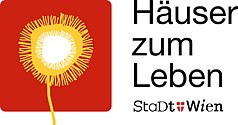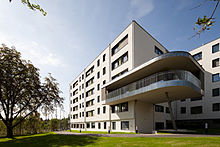Board of Trustees of Viennese Retirement Homes
| Board of Trustees of Viennese Retirement Homes
|
|
|---|---|
| legal form | Non-profit fund under private law |
| founding | 1960 |
| Seat | Vienna |
| management | Gabriele Graumann |
| Number of employees | around 4000 |
| Branch | Care and care of the elderly |
| Website | www.kwp.at |
The Kuratorium Wiener Pensionisten-Wohnhäuser (KWP) is a non-profit, private-law fund of the City of Vienna with legal personality . He runs a total of 30 houses to live in, 150 pensioners' clubs in the city of Vienna , focus stations for elderly people with disabilities and a care center for people with dementia, as well as its own training center. The KWP is not administered by a municipal department. It reports to the City Council Office (Business Group) for Health, Social Affairs and Sport. The President of the KWP Board of Directors is City Councilor Peter Hacker. Gabriele Graumann has been managing director since 2008.
history
In 1960 it was founded as a non-profit fund by resolution of the Vienna City Council. Just three years later, the first house with the name "Sonnenhof" was opened. A new store opened almost every year until 1995. In 1996 it was renamed the Kuratorium Wiener Pensionisten-Wohnhäuser (KWP). In 2001 the pensioners' clubs of the City of Vienna were incorporated into the KWP.
In 2012, the range of services was expanded to include “ assisted living ”. This fundamentally changes the collection modalities. New residents are now ranked according to need and not according to the length of the registration period. In the same year the new residential and nursing home "Haus Döbling" was completed. In the following year, the residential and nursing home "Haus Rosenberg" was ready for occupancy. The residential and nursing home “Haus Liebhartstal” was completely renovated in 2014 and expanded with a new building. In 2015 the newly renovated houses “Föhrenhof” and “Laaerberg” were opened. In 2016, the “Augarten” house will open after a thorough renovation.
task
The purpose of the board of trustees is to give Viennese senior citizens in the last phase of life in a needs-based environment security and as far as possible everyday normality. This is done taking into account their individual life paths and experiences as well as their increasing physical frailty. Since January 1, 2012, the allocation of residential and care places has been carried out by the Vienna Social Fund.
target group
The 30 houses for living are open to all older Viennese who meet the following requirements:
- Main residence in Vienna for at least six months
- Austrian citizenship or equivalent
- Your own consent
- Corresponding care needs
In principle, moving in is also possible without a care allowance level . The Döbling house in Vienna's 19th district is an exception . At least care allowance level 3 is required to move in.
Offer and services
The offer of houses to live in is divided into three basic categories:
- Assisted living: Aimed at seniors who have no need for care, but can no longer live at home for good reasons. Examples of such a need are apartments on upper floors when no elevator is available or the risk of loneliness in old age.
- Assisted living: General living for senior citizens with care allowance level 1 to 7.
- Well-maintained.Living / care space: This type of living is intended for people in need of care by qualified staff around the clock. The offer can be used from care allowance level 3.
While the Vienna Social Fund decides on the allocation of an apartment in the KWP , the specific needs and the related service packages are determined in the KWP.
Special offers
The KWP operates priority stations for residents with specific care needs in four buildings.
- Remobilization: The remobilization stations in the Wieden and Atzgersdorf houses offer after certain operations - such as B. hip operations - or after a stroke, medical and nursing care as well as occupational and physiotherapy. The aim is to reintegrate into the familiar environment.
- Care for people with dementia: the care center in Haus Rosenberg looks after mobile, disoriented residents with behavior patterns that are difficult to integrate in a suitable environment. This ensures the greatest possible degree of freedom and self-determination. The Naomi Feil validation is used to maintain values .
- Assisted living for people with disabilities: The centrally located houses Mariahilf and Neubau offer assisted living especially for older people with disabilities.
Another special offer is the Tag.Family . It is a form of day care that aims to create a structured daily routine for people who are no longer able to organize themselves. Through meaningful tasks and preserved as much as possible everyday normality that is self-confidence strengthened. This can delay the need for full-time care.
Retirement homes operated by the KWP
With the exception of the 1st and 8th districts of Vienna, there is at least one KWP house in each district. The first house was opened as "Haus Sonnenhof" in 1963 and is no longer in operation. Since 2008 a total of eight houses have been completely renovated or newly built for living. A total of 275 million euros were invested between 2007 and 2015.
The general renovation of the "Penzing" house will begin in summer 2017. "Haus Schmelz" will follow in 2019 and from 2021 the "Haus Haidehof" will be renovated.
Catering
The KWP operates the largest fresh kitchen in Vienna. Around 36,000 meals are cooked every day in all 30 houses. In 2015, the proportion of ready meals was only 2.8 percent. The organic share was around 35 percent. The proportion of food from Austria is around 74 percent, 20 percent come from the EU and 6 percent from non-EU countries.
These large quantities are preferably purchased regionally and seasonally. Planning and control are carried out centrally with the help of the KOST inventory management software. A component menu is used . This means that every single kitchen knows well in advance the ingredients that it will receive on a particular day. The specific form of processing is left to the respective chefs.
Pensioners' clubs of the city of Vienna
The city of Vienna's 160 pensioners' clubs are also operated by the KWP. The facilities go back to the warming rooms of the city of Vienna, which were built in the winder 1946/47. They see themselves as places of social gathering, entertainment and advice. Visiting the clubs is free but requires a one-time registration.
Web links
- Board of Trustees of Viennese Retirement Homes (official)
- Pensioners' clubs of the city of Vienna
- The KWP in the Vienna Foundation and Fund Register
Individual evidence
- ↑ Board of Trustees Wiener Pensionisten-Wohnhäuser continues the successful way of modernizing its houses to life. In: ots.at. PID Press and Information Service of the City of Vienna, June 8, 2017, accessed on August 17, 2017 .
- ↑ http://www.kwp.at/gutessen.aspx. Retrieved September 14, 2016 .
- ↑ Climate-friendly shopping. wien.gv.at, accessed on March 30, 2016 .



